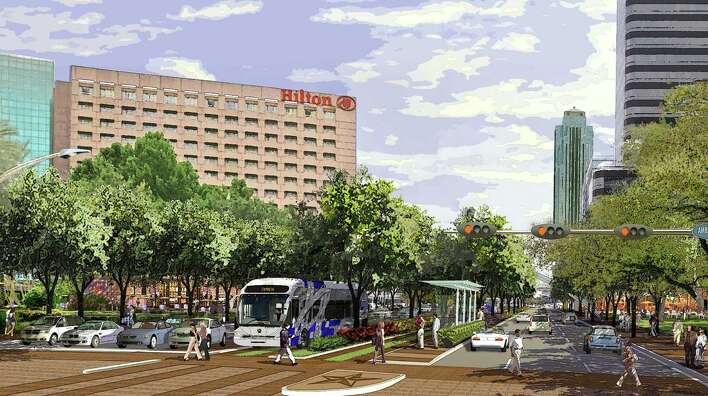Ed Wulfe never mentions Mattress Mack or his recent diatribe in the Chron about the proposed Uptown/Memorial Park TIRZ, but his op-ed in the Chron is clearly aimed at countering naysayers like Mattress Mack.
Uptown is one of the most successful mixed-use urban environments in the United States and a leading economic driver of Houston; yet, Uptown has been historically underserved by public transportation. This is a major concern expressed by employers in the area or those considering a new location in Uptown because a functional and efficient means of mobility for their employees is critical to productivity and an ability to retain and attract workers.
More than 75,000 people work at the 2,000 plus businesses in approximately 23 million square feet of offices, 5 million square feet of retail and 7,000 hotel rooms. Sixty-five percent of Uptown’s workforce currently lives in the Sugar Land, Westpark, Katy or Cypress areas, and the ability and need to connect workers to Uptown is an ongoing and increasing challenge.
This plan, while primarily designed to serve the workforce of the Uptown area, also enables movement to, from and through the corridor more efficiently in both directions.
The widening of Post Oak Boulevard will allow for construction of bus rapid lanes within a landscaped median while still preserving six lanes totally dedicated for automobile traffic.
The plan is designed to connect with Metro’s Northwest Transit Center and the proposed Westpark Transit Center. Exclusive bus lanes will remove buses from general traffic lanes while augmenting pedestrian access. The existing traffic signal system and left turn lanes will remain as is, and Post Oak Boulevard’s signature oak trees will be preserved.
The plan before City Council has evolved based on growing transit needs in and around Uptown, and discussions with the city and the Memorial Park Conservancy to ensure the restoration, preservation and improvement of Memorial Park, a major amenity and connector to downtown Houston.
Two points come to mind. One is that this plan isn’t just about Uptown mobility, it’s also about reforesting Memorial Park, which abuts Uptown to the northeast. Mack never touched on this in his rant, but the two are a package deal. There may be a way to fund Memorial Park reforestration that doesn’t involve Uptown, though such a thing isn’t on the table as far as I know, and one could argue that the Uptown mobility part of this plan should be removed, but then what does Uptown get out of it? Basically, this is the plan to reforest Memorial Park. If you approve of that idea but don’t like the other parts of the plan, then you need to propose an alternative plan. What other options are there?
Point two is that the same thing holds true for Uptown mobility. Mattress Mack, as is often the case with opponents of mass transit in general or to specific plans, doesn’t offer a competing vision for Uptown. The closest he comes to that is at the end of his piece when he says “More than 80 percent of our region lives and works in the suburbs, so obviously that is where we need to concentrate our efforts”, which is both a dubious statistic (he gives no citation) and beside the point – it’s not the city of Houston’s responsibility to abet mobility in the non-Houston suburbs, though plenty of our Harris County tax dollars do just that. Assuming that you agree that doing nothing is not a good option for Uptown, what would you do to improve mobility there? Remember, this isn’t just about building dedicated lanes for BRT on Post Oak, it’s about connecting Uptown to the greater Metro park and ride network, via the Northwest and Westpark transit centers. If you don’t support that, what do you support?
Anyway, the plan is still in flux, as Council has not had a chance to discuss it yet. The BRT plan depends in part on grant funding from the Houston-Galveston Area Council, but that funding has not been approved and may not be guaranteed despite strong support from the Greater Houston Partnership. It’s possible this could all fall apart, in which case Mack will have ranted for nothing. I hope it doesn’t come to that, but nothing is certain until it’s done.


You asked about other options for Memorial Park. Nature’s “original plan” is one that could be considered. After completion of the removal of hazardous dead trees and the soil disturbance inherent in that, the forest could simply be left to regenerate itself, with a little assistance from us humans in controlling invasive species. thinning, etc. This approach may be a little too “zen” for Houston. I personally would like to see some of the energy that’s currently devoted to planting new trees be re-directed to the care and maintenance of those already planted, which to a large degree are victims of long-term neglect. Two months ago, I reported approximately 25 trees in the Theater District downtown to 311, using their new photo and GIS-friendly app, because of girdling being caused by the hardware surrounding said trees. I was informed by 311 that this was an “invalid” report and that it would be re-directed to the Downtown District. To date, that entity has taken no action. This is just one of many examples of neglect that I could mention.